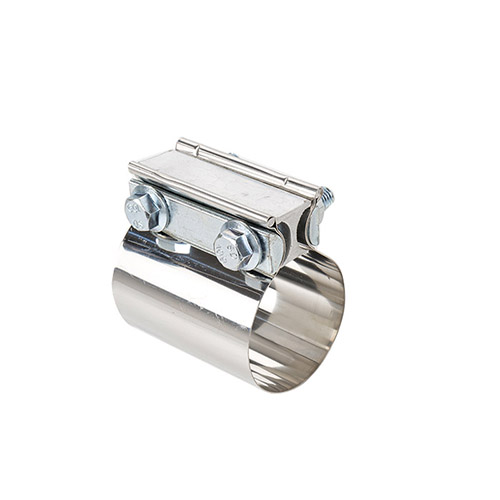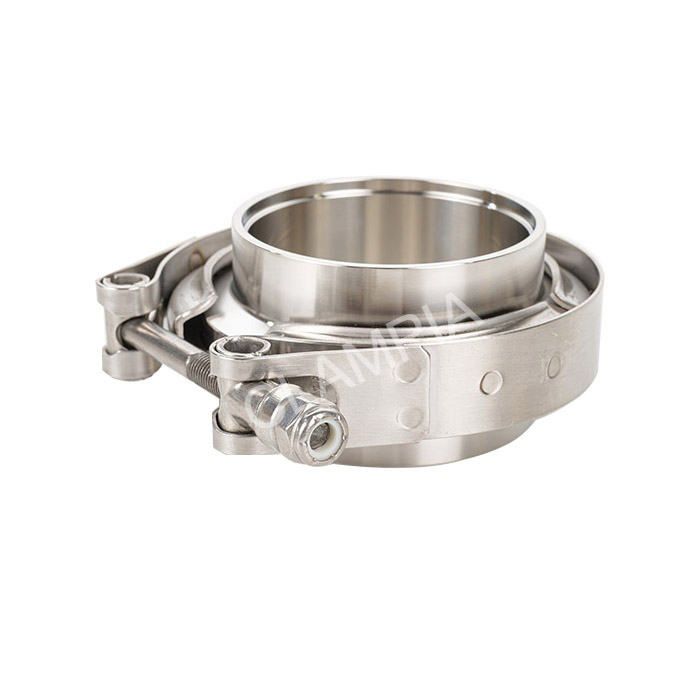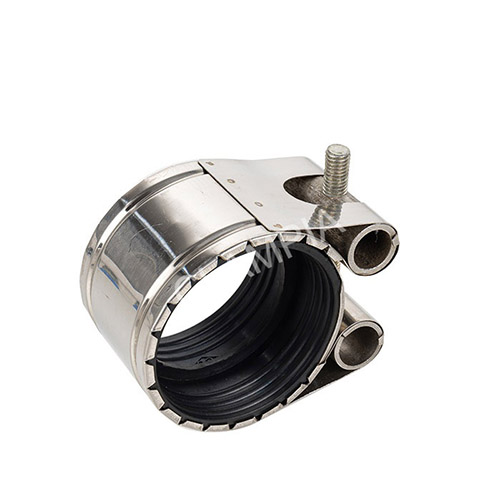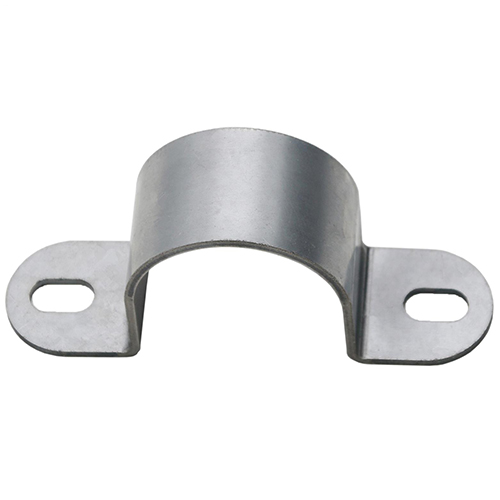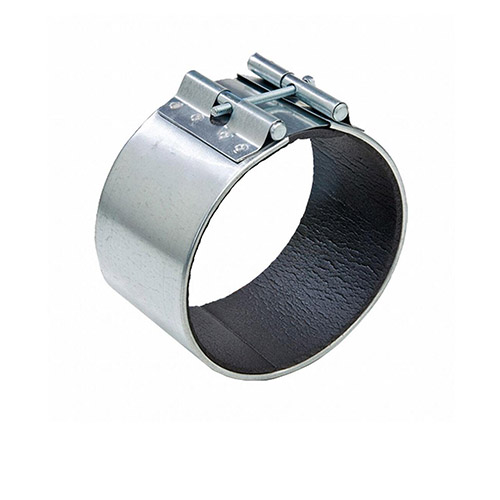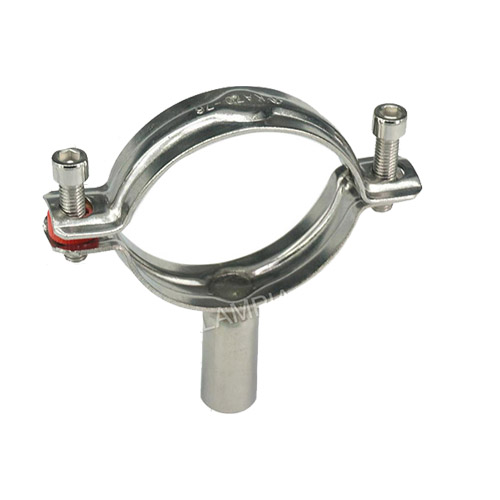PIPE CLAMP MANUFACTURER
CLAMPIA is a clamp manufacturer that offers types of metal pipe clamps, plumbing clamps, water pipe clamps, clevis hanger, exhaust v-band clamp, u bolt clamp, band clamp, sleeve clamp, sanitary clamp, cast iron clamp, aluminum clamps, etc. These are suitable for wide applications.
REQUEST A QUOTE FOR MORE DETAILS
All You Need To Know About Pipe Clamps
Pipe Clamps
Brief
A pipe clamp is a must-have for any plumber or pipe fitter. This simple but essential tool allows you to quickly and easily connect pipes, allowing for a secure and reliable connection. While many types of pipe clamps are on the market, they all serve the same basic purpose.
A pipe clamp usually consists of two halves that clamp around the pipe, with a bolt or other fastener holding the two halves together. This design makes it easy to attach the clamp to the pipe and allows for quick release if necessary. Pipe clamps are typically made from durable metals such as steel or copper, ensuring long life and reliable performance. A pipe clamp is a necessary tool whether you’re starting a construction project or fixing a leaky pipe.
Size
When it comes to size, pipe clamps are available in a wide range of options. The most common sizes are from 1″ to 26″, but specialty options are also larger or smaller as needed. The size of the clamp you need will depend on the project you’re working on and the size of the pipes you’re using.
When choosing a size, always avoid caution and choose a clamp that’s slightly larger than you think you need. This will provide you more wiggle room and the ability to change the clamp if needed.
Body Materials
Pipe clips and clamps attach pipes to walls, ceilings and floors. Plastic, copper, stainless steel, brass, and chrome are just a few of the materials used to make them. Every material has advantages and disadvantages, so it’s vital to pick the best one for the task.
- Carbon Steel
Carbon steel is the most popular material for pipe clamps. It is strong and durable, making it ideal for heavy-duty applications. However, it is also susceptible to corrosion, so choosing a clamp with a rust-resistant finish is important.
- Stainless Steel
Stainless steel is strong and durable, making it ideal for use in a pipe clamp. It is also resistant to rust and corrosion, which is important in an environment where pipes are constantly exposed to moisture.
- Aluminum
Aluminum is a popular metal for construction and manufacturing due to its strength, light weight, and resistance to corrosion. Aluminum is also a heat and electricity conductor, making it suitable for use in a variety of applications. For these reasons, aluminum is an excellent choice for pipe clamps and other industrial applications.
- Plastic
You need a material that is easy to work with and won’t damage your pipes. That’s why plastic is the perfect material for pipe clamps.
Plastic is strong enough to handle even the most strenuous jobs but is also lightweight and easy to maneuver.
Plus, plastic is non-conductive, so that it won’t cause any damage to your pipes.
- Copper
Copper is strong and durable yet flexible enough to allow a tight fit. It is also resistant to corrosion and won’t tarnish over time.
In addition, copper is an excellent conductor of heat, making it ideal for use in hot water lines. For these reasons, copper is the material of choice for many plumbing applications.
- Brass
Brass is a good choice for high-pressure applications because it is both strong and long-lasting. It’s also resistant to corrosion, which is vital if you work in an environment with dampness or chemicals.
- Alloy Steel
Alloy steel is ideal for heavy-duty applications because it’s strong and durable. It’s also resistant to corrosion and works well in damp or wet environments.
However, alloy steel is also susceptible to damage from impact, so it is important to choose a clamp designed to withstand the forces that will be applied to it. An alloy steel pipe clamp can provide years of reliable service with proper care.
- Chrome/Chrome-Plated pipe clamps, etc
The chrome and chrome-plated are very durable and resistant to corrosion. They also have a very high shine, giving your project a professional look. However, they can be components, so if you’re working on a budget, you may want to consider other options.
Types of Pipe Clamps
A wide range of piping clamps is used in industrial settings, depending on the purpose, materials, function, usage, etc. The following are some of the most frequent pipe clamps:
Exhaust Clamps
Exhaust clamps are designed to endure high temperatures and secure two pipes together. If you’re looking for a reliable clamp that can handle heat well, band, U-bolt, or V-band clamps are your best bet.
- Band Clamps

The most common type of clamp for a band is an adjustable metal band. Metal bands are versatile and permanent clamps, often made of aluminum, galvanized, or stainless steel. It will fit most muffler exhaust pipes and has various adjustability options. They’re simple to attach and tighten with the right clamping tool. Galvanized or stainless steel are more heat-resistant alternatives.
- U-Bolt Clamps

U-bolt clamps have many uses but are most commonly seen on automotive muffler systems. As the name suggests, U-bolt clamps have a U-shaped bolt that fits around the pipe. When you tighten the clamp, the bolt pushes the pipe into a toothed brace that won’t allow the pipe to turn or come apart. The size of the U-bolt clamp varies to fit any exhaust system.
- V -Band Clamps
A V-band clamp is the most complicated of the three. It has three parts, one for each pipe end that creates a lip and one for the collar that you place over the two to keep them in place. The groove in the collar piece that holds the two pipe ends together has a V shape for maximum tightness when clamped down. These clamps have one disadvantage: You must weld the components onto the pipes’ ends.

Other clamps
- Compression pipe coupling

A compression pipe coupling is an essential part of any pneumatic conveying system. They provide a quick and easy way to connect two pipes and are available in various sizes to suit different applications.

A compression pipe coupling is made from precision machined parts and is available in both stainless steel and aluminum. They can be used in pressure and vacuum applications and are suitable for use with various materials.
Compression pipe coupling provides a reliable and secure connection between two pipes and is essential to any pneumatic conveying system.
Other clamps
- Adjustable Pipe Clamps

These versatile clamps are made from steel, plastic, or aluminum for easy adjustment to the required pipe diameter. They can be quickly tightened or loosened to accommodate different pipe OD sizes without having to remove and replace the entire clamp each time.
This makes them ideal for use in various applications where frequent adjustments are needed. Not only are they perfect for use at home, but their versatililty makes them ideal for commercial settings as well.
- Cushioned Pipe Clamps

A cushioned pipe clamp is a specialized type of pipe clamp that contains a cushioning material. This material is designed to help avoid galvanic corrosion, which can occur when metal-to-metal contact occurs. Galvanic corrosion is a major problem for many industries, and it can cause serious damage to equipment.
The cushioned pipe clamp helps to prevent this type of corrosion by keeping the metal surfaces from coming into contact with each other. This allows for a longer lifespan for the equipment and helps to protect it from damage.
- Rigid Clamps

Rigid clamps are simple, durable, and easy to use. Made from steel or iron, they are ideal for various applications. Single-body pipe clamps are perfect for small projects, while two-piece pipe clamps are more versatile and can be used for larger projects.
Screwing the clamp onto the pipe is straightforward, making it a great option for DIYers or anyone looking for an easy-to-use clamp. Durable and reliable, rigid clamps are a great addition to any toolkit.
- U-bolts

The most popular pipe clamps are U-bolts. Small bore piping is frequently used with U-bolts. They may be utilized as a rest+guide+hold down or a rest+guide+hold down+line stop for small bore piping systems. Their usage is limited to pipes with a diameter of 8 inches and up since the heavier loads imposed by bigger pipe sizes limit their application.
- Two-Bolt Pipe Clamp

Two-bolt pipe clamps are a versatile and handy tool around any home or workshop. They can be used for various tasks, from hanging bare pipes to supporting small loads.
While their load-carrying capabilities are not large, they are still useful for many applications. Two-bolt pipe clamps are easy to use and require no special skills or training to operate.
- Three-bolt Pipe Clamp

Three-bolt pipe clamps are an excellent method to secure insulated lines transporting high-temperature liquids. The length of the clamp on top of the pipe is extended to accommodate the third bolt, which is placed outside the insulation. This enable more options as to where you can attach the pipe clamp and also makes it easier to remove the clamp if necessary.
The three-bolt design also provides greater stability than two-bolt clamps, making them ideal for high-pressure applications. When choosing a three-bolt pipe clamp, select one made from high-quality materials with robust construction.
- Yoke-Type Pipe Clamp

Yoke-type pipe clamps are used for hanging high-temperature horizontal insulated pipes. Pipe clamps that can securely support pipes with 4″ – 6″ of insulation are easy to find.
The clamps consist of two halves, which are hinged at the bottom. The halves are then brought together and held by a pin at the top.
This design allows the clamps to be quickly installed and removed, making them ideal for use when the pipe needs to be frequently accessed.
In addition, the compact size of yoke-type pipe clamps makes them ideal for use in cramped spaces. Despite their small size, these clamps can support a significant amount of weight, making them a piece of essential equipment for any tradesman or DIYer.
- Riser Pipe Clamps

Riser pipe clamps are an essential part of any plumbing system. They’re utilized to support lines that don’t require hanger roads. Both ears of the clamp are placed on the floor or structural member to move the pipe loads.
If the pipe is too hot, these clamps should not be used. They are, however, a necessary component of every plumbing system. Without them, pipes would sag and eventually break, causing extensive damage to your home or business. Riser pipe clamps are a simple yet essential part of ensuring that your plumbing system runs smoothly and without incident.
- Pipe Clips:
Pipe clips are a must-have for any plumber worth his salt. These versatile little tools can support horizontal or vertical pipes, making them an essential part of any plumbing job. Pipe clips are easy to install; simply bolt the clip directly to the structure you’re working on.
This allows you to direct your pipes where you need them to go without worrying about whether they’ll stay in place. Whether working on a new construction site or retrofitting an old one, pipe clips are a valuable tool that no plumber should be without.
- Heavy Duty Pipe Clamps

Heavy-duty pipe clamps are designed to support higher loads than standard pipe clamps. Most of the pipe clamps on the market are available in standard and heavy-duty variants to choose the right clamp for your needs.
Heavy-duty clamps are typically made of thicker materials and have stronger jaws so that they can grip the pipe more tightly. They also often have a larger throat opening to accommodate larger pipes. Choose a heavy-duty pipe clamp if you need to support a higher piping load.
- Extended Pipe Clamps

Extended pipe clamps may be required in some applications. These clamps are configured so the bottom piece can be extended, providing additional support for the pipe. Extended pipe clamps are typically used in applications where there is a need for extra stability, such as in high-pressure or high-temperature applications.
In addition, extended pipe clamps can also be used to support heavier pipes that might otherwise sag or wobble. While extended pipe clamps are more expensive than traditional pipe clamps, they offer several advantages that make them worth the investment.
- Multiple Pipe Clamps
In other applications situation, it may be necessary to use extended pipe clamps. These clamps are configured so the bottom piece can be extended, providing additional support for the pipe. Extended pipe clamps are typically used in applications where there is a need for extra stability, such as in high-pressure or high-temperature applications.
In addition, extended pipe clamps can also be used to support heavier pipes that might otherwise sag or wobble. While extended pipe clamps are more expensive than traditional pipe clamps, they offer several advantages that make them worth the investment.
- Hold Down Clamps

Hold-down clamps are an essential part of any pipe system that needs to withstand high vibrations. Pipe clamps made of high-tensile steel ensure that the system remains intact by locking down pipes and reducing vibrations.
In addition, hold-down clamps can be used to secure other types of equipment, such as valves and fittings. By using hold-down clamps, you can rest assured that your system will withstand even the most intense vibrations.
- Basic Steel Clamps
Steel clamps are an essential part of any pipe support system. Made from two bent pieces of steel, they provide a secure and reliable way to fasten pipes. The bolts that bind the two pieces together create a strong and durable connection, ensuring that your pipes stay where you need them.
Additionally, the steel material is resistant to corrosion, making these clamps an ideal choice for use in wet or humid environments. Whether you’re securing pipes for home plumbing or commercial applications, steel clamps are an excellent option.
Features of Pipe Clamps
All of the pipe clamps listed hereafter provide these features:
- Flexible Use:
Pipe clamps can be used for a variety of purposes like fastening pipes, holding objects together,
- Easy installation:
Most of the pipe clamps are very easy to install. You need to fix it with the help of screws. Some of them also come with an adhesive pad for easier installation.
- Easy to use:
Pipe clamps are very easy to use. You need to fix it with the help of screws. Some of them also come with an adhesive pad for easier installation.
- Nice appearance
Pipe clamps are not only rust-resistant, but they’re also paintable, making them more durable and visually appealing.
- Customizable:
You can cut pipe clamps to your desired length and shape them according to your needs.
- Reusable:
Pipe clamps are reusable so that you can use them again and again.
- The temperature is adaptable.
Clamp lining materials are not created equal. EPDM, Silicone and Neoprene lined clamps have temperature limitations that must be considered when choosing the right clamp for the application.
- Impact resistance
Pipe clamps are subject to various forces that can cause them to fail. The most common type of force is impact, which can occur when the clamp is dropped or struck by a heavy object. Impact resistance is, therefore, an important criterion for evaluating pipe clamps.
- Shock-absorption property
The unique shock-absorption capacity of pipe clamps protects delicate pipes and tubing from harm. When properly installed, a pipe clamp will help to cushion the blow if a pipe is struck by a tool or material.
- Vibration dampening property
Industrial pipe clamps are designed to provide a high level of vibration dampening, which is an important property in many applications.
The construction of the industrial pipe clamp allows it to absorb vibrations effectively, which can damage sensitive equipment or interfere with the operation of machinery.
- Acoustic reduction property
Acoustic reduction is a characteristic of pipe clamps that works to reduce noise. The Independent Suspension Mount (ISM) has outstandingly absorbed vibration and noise.
- Heavy torque
Pipe clamps are heavy-duty clamps that can be used to firmly secure pipes in any location. These materials are tough and can take a lot of punishment without breaking. The grip is also firm, so it won’t slip even if you’re exerting a lot of force.
- Suitable for both small and large diameter pipes, as well as other applications.
Pipe clamps are designed to hold pipes of various sizes and materials. They can be used to keep various pipe types, including copper, plastic, and even metal, in place.
Applications of Pipe Clamps
Pipe clamps are a frequent tool in the construction and plumbing industries. The following are some of the most common applications for pipe clamps:
- To fasten and fix pipes with structures to provide support.

Pipe clamps are commonly used in both industrial and household applications. In industry, they are often used to fasten and fix pipes with structures to provide support.
This can be anything from support for a column or machine to a secure connection for a fuel or water line. In the home, pipe clamps can be used for various tasks, such as fastening pipes together, repairing leaks, or holding wood in place while it dries.
- To provide fast, safe, economical service and installation in a piping system.

Pipe clamps provide a fast, safe and economic way to install or repair a piping system. Many types of pipe clamps are available, each designed for a specific task.
For example, pipe clamps can be used to secure pipes to walls or ceilings, connect pipes of different diameters, or repair leaks. Pipe clamps are also used to construct scaffolding and other temporary structures.
- Not only are pipe clamps useful for plumbing, but they can also be employed in a variety of other binding projects.

Pipe clamps are versatile tools that can be used for various fastening applications. Most commonly, they are used to secure pipes, but they can also clamp objects together for welding or soldering.
In addition, pipe clamps can be used to create a temporary seal around a pipe or tube. This is often done when a pipe needs to be repaired or replaced.
- The pipe clamps can also absorb shock, dampen vibration, and reduce noise.
Securely holding pipes in place prevents them from moving and banging against each other, which can cause damage and noise. That makes pipe clamps an ideal solution for reducing vibration and noise in plumbing systems.
Selecting a Pipe Clamp
To select a pipe clamp for a certain application, various parameters must be taken into account, such as:
Pipe Material

When choosing a pipe clamp, you must consider the type of pipe you’re using. Different materials can have different effects on the clamp, and in some cases, you may need to use a different material for the clamp altogether.
For example, stainless steel pipes need a stainless steel clamp to avoid galvanic corrosion. Similarly, if you’re using a plastic or PVC pipe, you’ll want to avoid metal clamps, as they can cause damage to the pipe. By considering the material of your pipe, you can ensure that your clamp will be compatible and provide long-lasting hold.
Pipe Temperature

Something to take into account with pipe clamps is temperature. Pipes will grow and contract due to the temperature of their material, meaning the clamping device must be able to endure those changes. Otherwise, the pipes could become loose or even break. There are a few different ways to account for this.
First, you can choose clamps made from materials that don’t expand or contract much in response to temperature changes. Second, you can select clamps that have a wide range of adjustability to accommodate expansions and contractions. Either way, it’s important to ensure that your pipe clamps can withstand changing temperatures.
Load Bearing Capability

When selecting pipe clamps, it is important to consider the load-bearing capability of the clamps. The catalogs from all manufacturers will tell you the maximum load-carrying capacity for both standard and heavy versions of pipe clamps. You should pick the clamp that can handle the loads your piping will create.
The most important factor in determining the load-carrying capacity of a pipe clamp is the bolt used to secure the band around the pipe. The size, grade, and number of bolts will all affect the load-carrying capacity of the clamp.
The width of the band is also an important consideration. A wider band will distribute the load over a larger area and thus increase the load-carrying capacity of the clamp. When selecting pipe clamps, it is important to consider all of these factors to select a clamp that is appropriate for the intended application.
Pipe OD

While selecting a pipe clamp, the diameter of the pipe, or the outer diameter, is an important factor to consider. Clamps are usually manufactured for a certain range of pipe diameters. As such, it is important to check the manufacturer’s catalog when selecting.
The wrong size clamp can damage your pipes and even cause them to fail. With so much on the line, you can’t afford to not select the perfect clamp for the job. By taking the time to do so, you’re ensuring your pipes are well-protected and equipped to handle any challenges that may come their way.
Working Environment
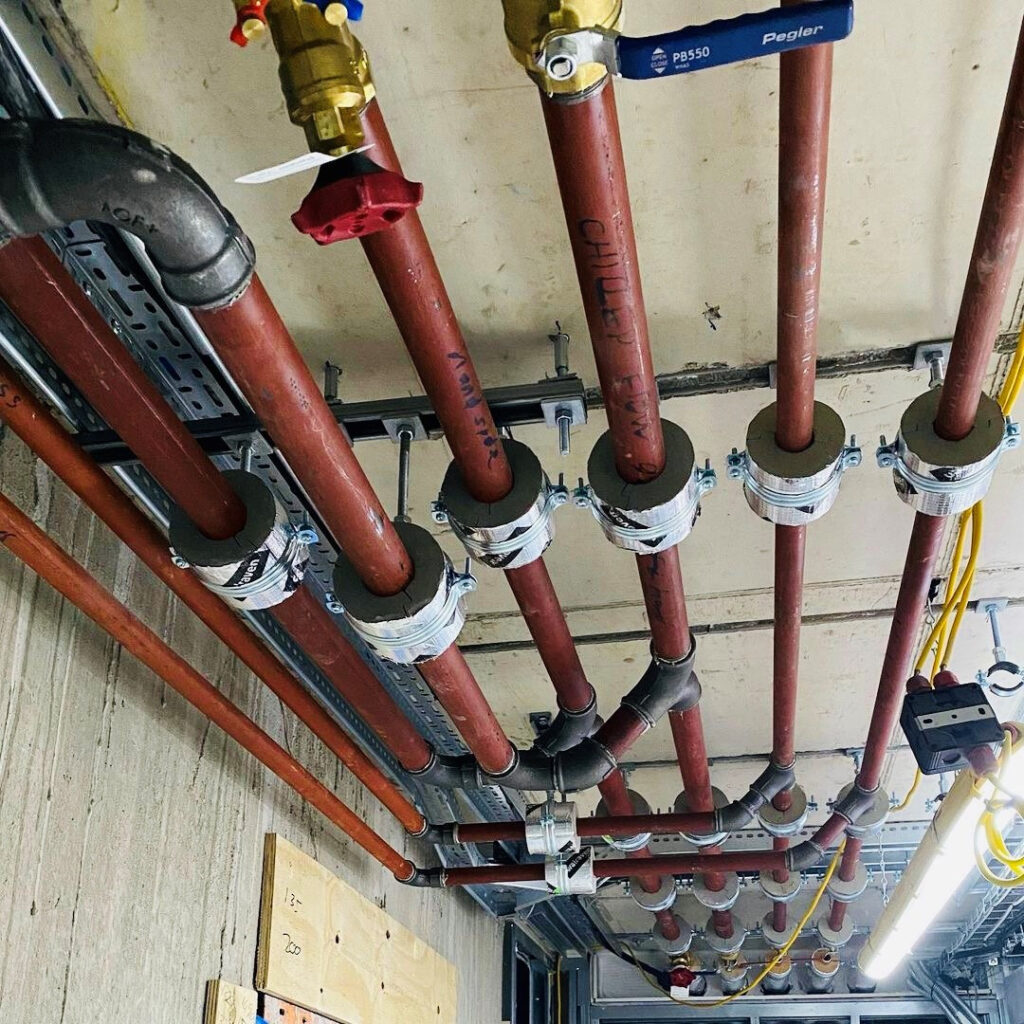
The working environment is a significant factor when choosing the type of pipe clamps. As the clamps will be exposed to the elements, selecting a material that is resistant to corrosion is important. For example, stainless steel clamps are ideal for damp or humid conditions, as they will not rust or corrode.
Similarly, vinyl-coated clamps are also well-suited for outdoor use, as they can withstand exposure to sunlight and heat. When selecting pipe clamps, it is important to consider the specific conditions where they will be used to choose a material that will provide lasting protection.
Special Requirements

While all pipe clamps perform the essential function of holding pipes in place, some clamps may be better suited for specific purposes than others. For example, some clamps feature rubber lining to help reduce vibration and noise, while others are designed to absorb impact.
Therefore, you must be careful to select the appropriate clamp for the task at hand. If you don’t, it could impact the quality of your work or even damage the pipe. With so many types of clamps available on the market, it can be daunting to make the right selection. A bit of research will take you far in finding the most suitable clamp for your project.
— FAQ LIST--
How to Use Exhaust Clamps
Exhaust clamps are fantastic when they are properly installed on the pipes. Follow these steps to learn how to use exhaust clamps correctly.
Step 1: Always remember to wear your safety gear (like gloves and glasses)
Step 2: First, loosen the U-bolt exhaust clamp. You can also use another type of clamp if you prefer.
Step 3: Slide the bolt into the clamp’s saddle on the exhaust pipe connection. Attach the clamp to each of the U-bolts’ legs with a hex nut. Do not tighten the hex nuts just yet.
Step 4: Place a towel or rag under the pipe and apply pressure to ensure that it sits correctly.
Step 5: Fix a 3/8 inch ratchet to a socket that matches the hex nuts’ size, and tighten it until fully tightened.
Step 6: Tighten each hex nut in turn after fixing the socket.
Step 7: Confirm that everything is tight.
Exhaust Clamps Vs. Welding: What Should We Do?
When your exhaust pipe is broken and dangling, welding or clamps for holding a danging exhaust in position may be a major issue. As a result, most individuals are perplexed because they continue to ask, “Is it preferable to weld or clamp an exhaust?”
Exhaust clamps are a more environmentally friendly than welding exhaust pipes due to their durability. Because of the numerous restrictions associated with welding, exhaust system connections utilizing clamps are much simpler and quicker than welding.
Although exhaust clamps can last up to 10 years on the pipes, they will eventually need to be replaced. The good news is that replacing them does not require special skills or processes, unlike welding. However, welding exhaust pipes makes them come out stronger than holding them in place with exhaust clamps. Welded pipes can last the pipe lifetime, unlike using exhausting clamps.
Welding exhaustion pipes requires expert welding skills, which most DIYers may not readily possess. If the DIYer has the skill, obtaining the proper tools is yet another limitation; hence, it would likely require calling in an expert welder for service.
Ultimately, it is up to the car owner whether they would like to weld exhaust pipes or use an exhaust pipe repair clamp. However, in some cases where a quick fix is necessary, using exhaust clamps may be best. Welding the pipe will provide more solidity and longevity; however, there are rear cases where welding simply isn’t possible, so using clamps is the better option.
Symptoms of a Bad or Failing Exhaust Clamp

An exhaust clamp keeps your exhaust in place and is usually necessary if you want to pass an emissions test.
While most modern cars have fully welded exhaust systems, exhaust clamps are still frequently utilized on the exhaust systems of many vehicles. Exhaust clamps are metal clamps used to hold and seal together different sections of the exhaust system.
Exhaust clamps are beneficial because they come in various shapes and sizes to exhaust pipes and can be adjusted as needed. When the clamps aren’t working right or have any other issues, it results in problems with the vehicle’s exhaust system, degrading engine performance. A failing exhaust clamp typically produces a couple of warning signs letting the driver know there could be an issue.
- Noisy exhaust

A loose exhaust clamp is a common problem that, fortunately, can be quickly and easily fixed. If you’re driving your car and suddenly notice that the exhaust noise has gotten louder than it used to be, this is likely the issue. The clamp is responsible for holding the exhaust pipes together; if it isn’t tight, it can cause an exhaust leak.
This will not only make your car louder, but it can also affect performance. If you’re experiencing this problem, the best action is to take your car to a mechanic and have them tighten the clamp for you. With a simple fix like this, you’ll be back on the road in no time.
- Loose exhaust components

If you notice that your exhaust system seems to be rattling or hanging loose beneath your vehicle, it could be a sign that the exhaust clamps are failing. The clamps are designed to hold the pipes together and create a seal, but if they’re not working properly, it can cause the pipes to come loose.
This can not only create a noise problem but can also lead to dangerous situations if the pipes become dislodged from the vehicle entirely. If you suspect your exhaust clamps need to be replaced, it’s best to take your car to a mechanic as soon as possible to fix the problem.
- Failed emissions test

Failing an emissions test is not only a pain but can also be costly. If your vehicle fails an emissions test, it’s likely because of a problem with the exhaust clamps. When exhaust clamps fail or come loose, an exhaust leak can form. This can affect the vehicle’s emissions output and cause it to fail an emissions test. To avoid this, regularly check your exhaust clamps and replace them if necessary.
Though basic in function and design, exhaust clamps are essential to a secure and sealed exhaust system. Have a professional technician inspect the system if you think your vehicle’s exhaust clamp may be damaged. Exhaust clamp replacements might be necessary.
Are exhaust clamps good?
Clutches and exhaust clamps are excellent, especially when installed correctly. Installing exhaust clamps may be the solution for a car’s exhaust pipe that has come loose and hangs off on its own in some circumstances.
Exhaust clamps are necessary for properly securing your automobile’s dangling exhaust system. If your car’s exhaust is in this condition, you should consider using exhaust clamps to repair it. Otherwise, the component may stay that way until it fails.
Do exhaust clamps leak?
It’s common for people to wonder whether their exhaust clamps might be leaking. After all, these clamps play an important role in holding the exhaust system together. And if any clamps become loose or fail, it could cause an exhaust leak. Such a leak might then impact the car’s emissions output. So it’s understandable that people want to know whether their exhaust clamps might be at risk of leaking.
Fortunately, it’s usually easy to tell if an exhaust clamp is starting to leak. If you notice any unusual noise coming from the exhaust system, or if you see any visible signs of leaks, then it’s likely that one or more of the clamps is starting to fail. In such cases, it’s important to fix the problem as soon as possible. Doing so can help ensure that your car continues to run smoothly and efficiently.
Do exhausts need to be welded?
Ultimately, it comes down to the car owner’s preference. Exhaust pipes can either be held in place with exhaust clamps or welded. Although clamps are sufficient, welding will do a better job at keeping the pipe secure. However, one downside to welding is that exhaust clamps tend to fail more easily in comparison.
The common question is, “Should I weld my exhaust or use clamps?” The answer is that welding your exhaust will make it more durable and last longer than using clamps. Exhaust clamps are not as reliable because they may need to be replaced before the pipe does.
Can a catalytic converter be clamped?
A catalytic converter can be clamped. However, if you’re not sure whether there are any exhaust leaks, it would be beneficial to double-check. The last thing you want is for your hard work to be lost because of a simple oversight. When using clamps or sleeves, ensure they are tight but not too tight.
You don’t want to damage the cat by over-tightening the clamps. A good rule of thumb is only to tighten the clamps until they are snug. If you need to, you can always tighten them a little more. Once the catalytic converter is clamped in place, check for any exhaust leaks. If there are none, then congratulations! You have successfully installed your catalytic converter.
Where should exhaust clamps be placed?
There’s no one answer to the question of where your exhaust clamps should be placed – it depends on the particular set-up of your engine. However, you’ll generally want to place the clamps on the exhaust pipe.
This will provide a secure hold while you’re working and help prevent any accidental damage to the pipe.
Fix the saddle (the clamping device) onto the exhaust pipe’s connection point and slide in the U-bolt. Once the U-bolt is in place, thread a nut onto each bolt’s legs. This will tighten the entire assembly and provide a stronghold for your exhaust system.
What is the lifespan of exhaust clamps?
“Do exhaust band clamps work?” you may be asking yourself. If you’re wondering how long exhaust band clamps last, don’t count on them lasting a century; nevertheless, they can endure for 10 years or more if used to keep an obstructed or dangling exhaust in place.
Male drivers are especially interested in the durability of these special clamps since they are constantly driving and using their vehicles for various purposes, including work and play. Exhaust clamps made of good quality materials can be expected to withstand extreme heat and rays without breaking down or failing.
In addition, the best exhaust clamps will have a powder-coated finish that helps to resist corrosion. When shopping for band clamps, it is important to pay attention to the quality of the materials to get the best value for your money. With a little research, you can find an exhaust clamp that will serve you well for many years.
What size exhaust clamp should I buy?
Exhaust clamps vary in size and style, so it is key to select the ones that fit your car’s exhaust componentry. When choosing between different types of exhaust clamps, keep an eye out for durability, a good seal, and ease of service.
For the best fit, we recommend using a 2″ exhaust clamp. It is designed to cover a car’s 2″ OD pipe. There is also some wiggle room with this size- it can accommodate pipes slightly less than 2 inches in diameter.
What would happen with the wrong exhaust clamps?
The most common exhaust clamps are the heat-treated stainless steel Exhaust Clamp and the black plastic Exhaust Clamp. The metal Exhaust Clamp is a two-piece design that includes an O-ring seal, while the plastic Exhaust Clamp features three O-rings.
It’s a good idea to inspect all exhaust clamps for wear and replace any that show signs of deterioration since they can be dangerous if not handled correctly. Exhaust clamps can cause problems in the future if you use them on modern automobiles.
- Sealability
While many car enthusiasts may be focused on horsepower and torque when choosing an aftermarket exhaust system, it’s important not to overlook the importance of sealability. The wrong clamp can create a loose exhaust seal, resulting in poor fuel economy, high emissions and – in some cases – the release of dangerous exhaust fumes into the cabin.
A properly sealed exhaust system is crucial for performance and safety, so choose a clamp that will create a tight, secure fit. With a little research, you can find the perfect clamp to keep your exhaust system functioning at its best.
- Durability
When it comes to exhaust pipe maintenance, there are a lot of important factors to consider. But one that is often overlooked is the durability of the used parts. This is especially true of exhaust clamps. Some clamps are designed for temporary use, while others are meant to last the vehicle’s lifetime.
Using the wrong clamp type can easily turn a muffler into a road hazard. That’s why it’s important to choose clamps that are both durable and easy to install. Exhaust clamps made from high-quality materials and featuring a simple design are typically the best for most applications. By choosing clamps built to last, you can avoid costly repairs and keep your vehicle running safely for years to come.
- Serviceability
Serviceability is one of the key things to consider regarding car maintenance. How easy would it be to access different vehicle parts for repairs or replacement? With muThis be easy because mufflers they’re often in tight spots.
Fortunately, many exhaust systems now feature clamps that can be removed without damaging them. This means that vehicle components near the muffler can be serviced without replacing the entire system. As a result, it will help to save you both time and money, making it an essential consideration for anyone who owns a vehicle.
What are the Different Types of Compression Couplings?
Compression Couplings Morris Type

- size
Bolted couplings are available in both heavy wall pipe size and tube size up to 24″Ø. The right size coupling will depend on the application and the type of pipe or tube being used.
For example, a smaller coupling may be sufficient for low-pressure applications, while a larger coupling may be required for a high-pressure application. There are so many choices that it’s critical to pick the appropriate size connection for your application.

- Installation
When it’s time to put your new and improved whatever in place, you’ll be relieved to know that installation is a snap. All you need is a 3/4″ wrench or deep socket. And if for some reason you need to take it down or move it, no problem! It’s easy to disassemble and just as easy to put back together again.
Plus, it’s reusable—another way we’ve made your life easier. Oh, and by the way, we have models available in 3, 4, 5, and 6+ bolt configurations to accommodate heavy wall installations safely. So rest assured, we’ve got you covered there too. The installation has never been so simple!
- Finish
Until the finish work is completed correctly, no job is finished. That’s why we only use the best materials for our finishing touches. We’ve got you covered, whether it’s galvanized with plated hardware or all stainless steel. We also have a variety of gaskets to choose from, including white nitrile, red rubber, silicone, EPDM, Viton and food grade.
This style of compression coupling is more expensive than the instalok type but is also more preferred.
Instalok Compression Couplings

- Size
There’s no question that size matters when choosing the right coupling for your application. That’s why we offer our bolted couplings in both heavy wall pipe size and tube size up to 4″, Ø. And Instalok couplings are available in various sizes to fit your specific needs.
But what sets our couplings apart is their installation speed and cost-effectiveness. Instalok couplings install 30% faster than bolt-style compression couplings, costing 20% less.

- Installation
Installing correctly is crucial for the success of any construction project. If done improperly, it can lead to costly repairs and delays. That’s why it’s important to use the highest quality products available. Grade 5 stress-relieved bolts are made from the strongest steel and are designed to withstand even the most difficult installation conditions.
With grade 5 stress-relieved bolts, you can be sure that your installation will be trouble-free. So when it comes time to install your next project, make sure to use the best bolts available. With grade 5 stress-relieved bolts, you’ll have peace of mind knowing that your installation will be done right the first time.
- Material
While stainless steel is often the material for many applications, it is not always the best option. In some cases, other materials may be better suited to the job at hand. This is certainly true when it comes to installing ok compression couplings.
While stainless steel would no doubt be durable and long-lasting, it is not available in this coupling style. However, other materials are available that can provide similar benefits. Instalok compression couplings are available with various gasket materials designed to provide a tight seal.
- Finish
All Instalok products are designed to resist weathering and corrosion. The standard finish is hot-dip galvanized with plated hardware. We also offer a host of other finishes to meet the requirements of any application.
Quick Couplings

- size
There’s nothing worse than fighting with a hose that won’t fit together properly. Quick couplings can save you time and hassle by making it easy to connect and disconnect your hoses. Quick couplings are available in 4″ and 9-1/2″ lengths for pipe from 1″Ø to 12″Ø and tubing 1-1/2″Ø to 12″Ø.
The clamps fit a wide range of applications, from pipe and tube to cast iron. They come in a variety of connection types to match your requirements. Quick couplings make it easy to change hoses or attachments to get the job done quickly and efficiently.
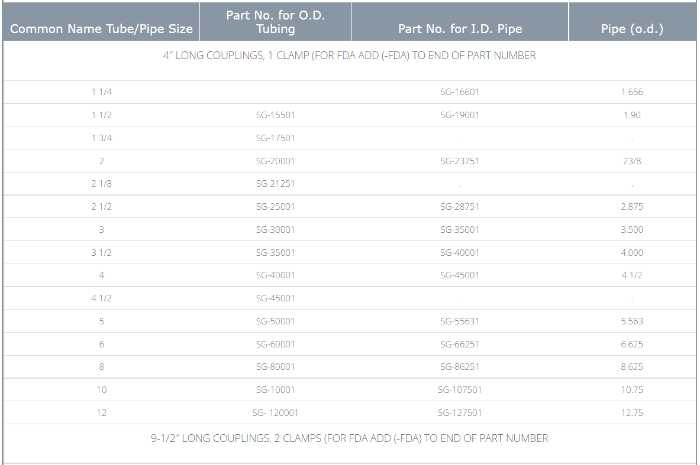
- Installation
Quick couplings are an effortless way to connect or disconnect lines without needing any tools, which makes them perfect for applications where lines need to be regularly switched out—such as in test rigs or production lines.
Quick couplings are also much less likely to leak than traditional fittings, reducing downtime. Installation is quick and easy, with most models requiring only a few seconds to tighten. Thread the coupling into place and hand-tighten the nut until it is snug. A wrench can be used to tighten the nut an additional half-turn for extra security.
- Material
Quick couplings are designed for use in a wide variety of applications, and they are available in a variety of different materials. The most common material for quick couplings is stainless steel. Stainless steel is strong and durable, making it ideal for applications where quick couplings are subject to frequent use or harsh conditions.
However, quick couplings are not only made of stainless steel. Quick couplings are also available in various plastics, including nylon and polypropylene. These materials are lighter than stainless steel, making them ideal for applications where weight is a factor. In addition, plastics are generally easier to manufacture than metals, making them more cost-effective.
Slip couplings for light Wall Systems
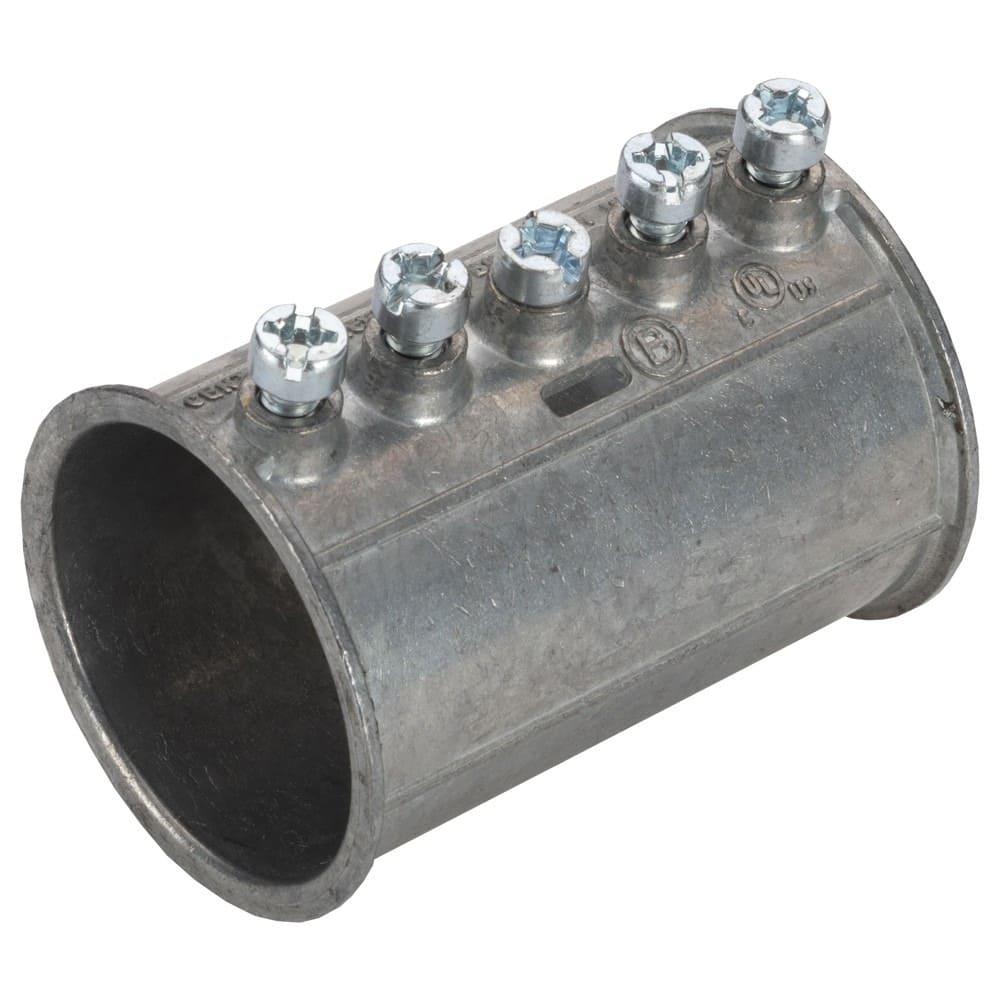
- Size
Slip couplings are an excellent method to join two unaltered termini of a tube or pipe. They’re available in sizes up to 6″ and are easy to install. Plus, they create a strong connection that won’t leak.

- Material
Slip couplings are an essential component of light wall systems. They allow for quick and easy connection of pipe sections while also providing a high degree of flexibility. Slip couplings are available in various materials, including carbon steel, galvanized steel, aluminum, and stainless steel. The various benefits and drawbacks to each material should be considered when choosing the appropriate coupling for your project.
- Carbon steel slip couplings are strong and durable but also susceptible to corrosion.
- Galvanized steel couplings offer excellent corrosion resistance, but they may not be as strong as carbon steel.
- Aluminum slip couplings are lightweight and easy to work with, but they may not be able to handle heavy loads.
- Stainless steel slip couplings are the most expensive option, but they offer the best combination of strength, durability, and corrosion resistance
How do pipe clamps work?
Tubing or cable is held in place by a pipe clamp. The pipe clamp is affixed to a wall or structure. Pipe clips are usually either gripping (anchor) or non-gripping (saddle/guide), depending on how tightly you want the conduit to be fixed. Some applications allow a little room for movement, whether thermal, mechanical or otherwise.
This is beneficial in some cases. The pipe clamps come in a variety of sizes and diameters to meet a variety of requirements. They’re constructed of different metals, including plastic, copper, stainless steel, brass, and chrome. There are also numerous bracketing and mounting options (single-screw, two-screw or three-screw, bolt-down, clip-in, etc.)
Pipe clamps are a simple way to ensure your conduit is securely in place. Whether you need a firm grip or a little wiggle room, a pipe clamp can do the job.
The best pipe clamp for the task will generally be determined by a few key considerations, in no particular order – the most significant of which are:
- What are you going to mount?
- Where would you like to mount it?
- How wide and far apart do the supports need to be so they can hold the weight along the entire length?
What are pipe clamps used for?
Pipe clamps are used in all home, industrial, and outdoor areas. They’re a fast and tidy approach to holding, securing, and guiding tubes or conduits for various plumbing, heating, and electrical applications. Pipe clips come in several materials, finishes, and styles to accommodate projects ranging from concealing thin cables to maintaining big-diameter waste disposal systems.
Pipe clamps for plumbing
Different clamps are required for different purposes, such as holding two pipes together or attaching a pipe to a wall. Plumbing clamps come in various sizes and shapes to best achieve their function.
- The worm-drive clamp is the most common plumbing clamp, which is tightened using a screw. This clamp is ideal for applications requiring frequent adjustments, such as when attaching a pipe to a moving object.
- Another common plumbing clamp is the spring clamp, which is tightened using tension. Spring clamps are often used in temporary applications, such as when holding two pipes together during soldering. When selecting a plumbing clamp, it is important to consider the diameter of the pipe, the material of the pipe, and the maximum load that the clamp can support.
Pipe clamps for drains
Most homes have a drainage system to carry away rainwater and wastewater. These systems usually include pipes, clamps, and brackets to secure the pipes in place.
Drain pipe clamps are an essential part of any drainage system. They help to keep the pipes securely in place, preventing them from moving or shifting. This is especially true in areas prone to strong winds or heavy rains.
Drain pipe clamps come in various sizes and styles to fit any type of pipe. They are made from durable materials that can withstand exposure to the elements.
Which pipe clamp materials are best for which jobs?
Pipe clamps are available in many materials, including stainless steel, aluminum, brass, titanium, and carbon steel. There are many more disparate materials used for pipe clamps than there are various diameters and mounting systems for them. The following are a few of the most prevalent materials used and some examples of how they suit certain applications.
- What are stainless steel pipe clamps best for?
Stainless steel is the way to go when it comes to tough, durable pipe clamps that can stand up to just about anything. These clamps are ideal for use in any setting where they could be exposed to moisture, corrosion, oxidation or similarly harsh environmental conditions.
Stainless steel is a good choice to go if you’re looking to secure some pipes in an outdoor application or need a clamp that can withstand exposure to chemicals or other corrosive materials.
And because they’re so tough and durable, you can rest assured that your investment will pay off in the long run. So when you need a clamp that can tackle the toughest jobs, reach for a stainless steel pipe clamp.
- What are copper pipe clamps best for?
For plumbing, copper is the material of choice for many homeowners and contractors. Not only is copper durable and long-lasting, it also has a natural resistance to bacteria and fungi. As a result, copper pipes and fittings are often used in indoor plumbing systems. Copper pipe clamps are an essential component of any such system, as they help secure the pipes.
Unlike other clamps, copper pipe clamps will not corrode on exposure to residual moisture. So they are the best option for use in high-moisture environments such as bathrooms and kitchens. In addition, copper pipe clamps are easy to install and require no special tools. They are also a popular choice for do-it-yourselfers and professional plumbers since they are inexpensive.
- What are brass pipe clamps best for?
Brass is a copper-zinc alloy that has many of the same characteristics as copper. It is both durable and flexible, making it perfect for a variety of uses.
Pipe clamps are one of the most common applications for brass. Brass pipe clamps are frequently utilized when a little bit of beauty is wanted, as the metal has a natural sheen that may give any location a touch of class.
Brass pipe fittings and clips are ideal for plumbing applications because, like copper, they don’t rust or discolor with long-term exposure to water.
In addition, brass is also a very effective conductor of heat, making it a great choice for radiators and other heating applications. Whether you’re looking for strength, durability, or style, brass pipe clamps are a great option.
- What are chrome pipe clamps best for?
Chrome pipe clamps are best used in high-pressure situations where you need a reliable, durable seal. The chrome plating on the clamp helps to resist corrosion and wear, making it ideal for use in tough environments.
The thick plating layers also make the clamp more resistant to damage from impact, making it ideal for use in situations with a risk of collision or vibration. Whether using them in a workshop or construction site, chrome pipe clamps are the best choice for a reliable, long-lasting seal.
Which pipe clip sizes are best for which jobs?
One of the first major judgments you’ll have to make when using pipe clamps for conduit or cable protection is what size or diameter to use for each type of application. Because various distinct grades of pipework are required for different supply lines and drainage outlets in plumbing applications, this is especially crucial.
- What are 10mm pipe clips best for?

10mm pipe clips are ideal for narrower ductwork, as found in many microbore central heating systems. While they may be used with copper, brass, or iron pipe, they are especially well-suited for sealing existing ductwork.
In addition to their efficiency in holding ductwork in place, 10mm pipe clips are also less likely to cause damage to the pipes themselves, making them the ideal choice for those concerned about the integrity of their piping. Whether you’re looking to secure new ductwork or replace old clamps, 10mm pipe clips are the perfect solution.
- What are 15mm pipe clips best for?

15mm pipe clips are the best way to secure copper, brass, or treated plastic tubing in your home or small business. These pipe clips are easy to install and provide a tight, secure fit that will prevent your tubing from coming loose over time.
Additionally, 15mm pipe clips are less likely to damage your tubing than other types of clips, making them the best option for protecting your investment. Whether you’re looking to keep your tubing safe from leaks or simply want to ensure that it stays in place, 15mm pipe clips are the best solution.
- What are 20mm pipe clips best for?

20mm pipe clips are ideal for a variety of applications. They can securely hold water pipes in place, both above and below ground.
In addition, they are perfect for holding irrigation piping in place. The design of the clip ensures a tight fit, while the material is durable and resistant to UV damage. As a result, 20mm pipe clips are an essential tool for anyone working with this type of tubing.
- What are 28mm pipe clips best for?

28mm pipe is usually considered the widest’ standard’ grade of water supply conduit for most household plumbing applications. It is critical to use the proper size and type of pipe clip when connecting this diameter of the water pipe to create a secure and reliable seal.
Different designs and materials are available for 28mm pipe clips, so it is important to choose one that is suitable for the job. For example, metal pipe clips are more durable and can be used in high-pressure situations, whereas plastic ones may be more suited to lower-pressure applications.
Ultimately, it is up to the individual plumber to decide which type of pipe clip is best for their needs. However, selecting the correct clip for the job makes it possible to create a solid connection that will not leak or come undone over time.
- What are 32mm pipe clips best for?

32mm pipe clips are ideal for bathroom and kitchen applications. They’re perfect for use with mid-sized appliances like basins, bidets, and similar waste pipes. These clips easily handle the moderate flow rate, ensuring a secure hold that won’t loosen over time.
The stainless steel construction guarantees the long-lasting durability you want, while the smooth finish protects against any marking or scratching of delicate surfaces. Installation is quick and easy, making these pipe clips an excellent choice for any do-it-yourselfer.
- What are 40mm pipe clips best for?

40mm pipe clips are ideal for use with treated plastic or stainless steel tubing in wastewater systems. This grade of tubing is often used to carry high-volume waste from baths and showers, and the 40mm pipe clips help to support the tubing and keep it secure.
These pipe clips are made from durable materials that can withstand the elements. They’re easy to install, so you can get your wastewater system up and running quickly and efficiently. Whether a professional plumber or a DIY homeowner, 40mm pipe clips are a great option for various applications.
- What are 50mm pipe clips best for?
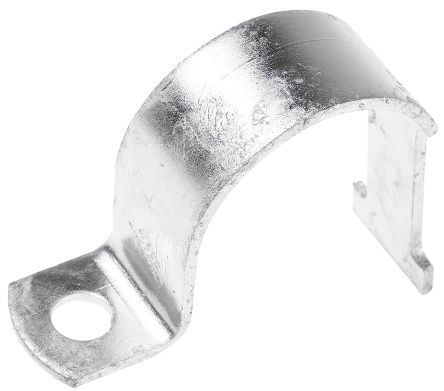
uPVC waste pipe clips are usually a good option for connecting waste pipes from various high-throughput household or commercial equipment, particularly when an excessively long run to outside drainage makes the 40mm diameter conduit a less suitable choice than usual. These installations will most frequently be constructed of uPVC or similar plastics.
Deciding Size of Pipe Clamps
The size of a pipe clamp is determined by:
- Pipe outside diameter
The outer diameter of metallic pipes is fixed, so clamps are chosen based on the pipe’s OD. Plastic pipes may differ from manufacturer to manufacturer, influencing the selection of piping clamps.
- Special Consideration
It’s possible to use clamps on pipe insulation in some situations safely, but when doing so, you must consider the thickness of the insulation.
How to Use Metal Pipe Clamps
Pipe clamps come in various designs, but they’re commonly used to connect pipes. You can connect two pipes using pipe clamps in several ways. There are many ways to use pipe clamps to help strengthen your pipes. Here are some examples:
Metal Clamps as Hangers
It’s key to hang pipes from above when working with them so they are out of the way and you can easily access them. Metal clamps do this perfectly.
You can easily and securely hang your pipes from any overhead structure by pairing your clamps with hangers. This is an excellent method for keeping your workspace clean and organized. Plus, it helps you avoid potential accidents. So next time you work with pipes, make sure to use metal clamps to keep them safely out of the way.
Metal Clamps as Elevators
Another popular use is to lift pipes up with them. When you combine clamps with pipe shoes, you may lift pipes off the ground or other surfaces. This is a simple method to raise and safeguard horizontal pipe runs.
This can be especially helpful in preventing damage to pipes buried underground or otherwise difficult to access. In addition, using clamps as elevators can make it easier to install new pipes or repair existing ones. So next time you need to elevate a pipe, don’t forget the power of metal clamps.
Metal Clamps as Vertical or Horizontal Supports
Metal clamps provide a fundamental level of support for your pipes, ensuring they remain securely in place. Whether your pipes are arranged in a vertical or horizontal configuration, metal clamps can be attached to surrounding support structures to provide the stability your pipes need.
In addition to helping prevent accidental damage, metal clamps make it easier to install and remove pipes for maintenance or repair.
Pipes require proper support, so pipe hangers are key to any pipe-related installation. When it comes time to select metal clamps for your project, be sure to choose a reputable brand – Clampia, that offers a variety of sizes and styles to suit your needs. With the right metal clamp, you can rest assured that your pipes will remain securely in place.
What Benefits Do Metal Pipe Clamps Bring to Your Pipe System?
How can metal pipe clamps help your piping system endure the test of time? They offer a variety of services, including protection and improvement. Here are some prevalent benefits of pipe clamps:
- Elevate Pipes
Having your pipes elevated by using metal pipe clamps can help you avoid having disasters in the first place. Water expands and puts pressure on a pipe when it freezes inside it. The pressure is too much for some pipes to handle, which is why they burst.
When pipes are resting on a hard surface and are clamped down, it takes away the chance of the pipes being able to move and rub against the surface. Another way to avoid water from leaking out of gaps is to fill the cracks with epoxy resin or putty, as well.
In addition, using metal pipe clamps can help to reduce the noise that often comes from banging pipes. Banging pipes are typically caused when the water pressure changes or when water flow is shut off quickly. When you use these clamps, you can eliminate this issue.
This is a must-do maintenance task. It not only helps your plumbing system function more efficiently, but it also gives you piece of mind knowing that it’s been properly maintained.
- Suspend Pipes
Any good pipe system needs support. Metal pipe clamps provide that support in various ways, depending on the design of the clamp. Some clamps function as beam clamps, resting on an I-beam or other structural element to support the weight of the pipes.
Other clamps, known as pipe saddles, fit around the circumference of the pipes and bolt to a support surface. This is ideal for attaching pipes to walls or ceilings.
Finally, some pipe clamps function as roller supports. Not only do these support the weight of the pipe, but they also allow it to roll freely; making them ideal for mobile applications such as construction site trailers. No matter your needs, a metal pipe clamp can provide the right level of support.
- Protect Pipes from the Elements
Pipe clamps provide that extra protection your pipes need in harsh outdoor environments. They keep your pipes secure and prevent them from contacting corrosive liquids or grime.
They also protect your pipes from inclement weather, ensuring they won’t come crashing down in strong winds or heavy rains.
In short, pipe clamps are an essential part of any pipe system that is exposed to the elements. By investing in quality pipe clamps, you can extend the life of your pipes and protect your investment.
- Cut Down Vibration Damage
Metal pipe clamps improve your pipe system by reducing vibration damage. Unanchored pipes can be banged against other objects, wearing down the pipe. Metal clamps help to reduce this by holding the pipe in place.
By absorbing and dissipating the energy of the vibrations, metal pipe clamps can extend the life of your pipes and prevent costly repairs. In addition, metal pipe clamps can also reduce noise levels, making your piping system more efficient and effective. As a result, metal pipe clamps are an essential part of any high-performance piping system.
How to Install Metal Pipe Clamps
Before using your new metal pipe clamp, ensure it is installed correctly. Pipes that are not properly supported can break and cause extensive damage. Here are a few things to keep in mind when installing your clamp:
Pay attention to the metals you’re using.
It’s critical to pay attention to the metals you’re employing before you begin utilizing your metal pipe clamps. Not all metals get along well. Galvanic corrosion can occur if the metal in your pipe clamps isn’t suitable with your pipes.
That’s why it’s important to consult a Pipe Clamp Compatibility Chart before you start your project.
Double-check your support spacing.
Before beginning your project, be sure to take some time to double-check the support spacing. This will ensure that your pipe clamps are properly spaced out and avoid any potential problems down the line. If your clamps aren’t properly spaced, it can cause the pipes to sag in between them.
This can then lead to corrosive pooling or put extra pressure on runs of pipe which can cause serious damage. By taking the time to do this simple check, you can save yourself a lot of hassle and potential headaches.
Tighten clamps with care.
Pipe clamps are secured with nuts and bolts, and they should be handled with care. If you tighten them too much, you risk stripping the bolts, and if you don’t tighten them enough, pipes may hit your clamps and cause damage.
To avoid this, always use a torque wrench when tightening clamps. When correctly installed, metal pipe clamps will provide a secure and reliable hold on your pipes, making them an essential part of any plumbing job.

